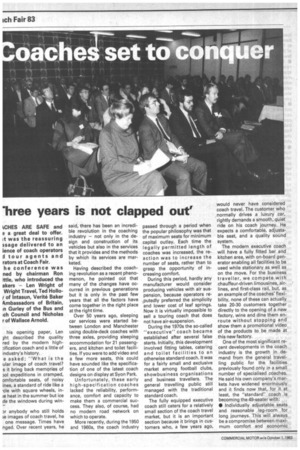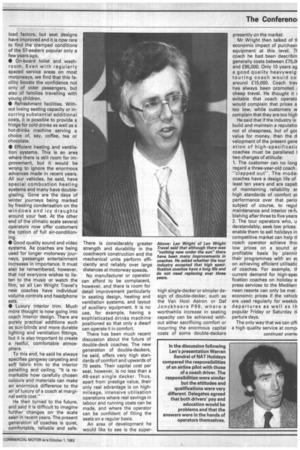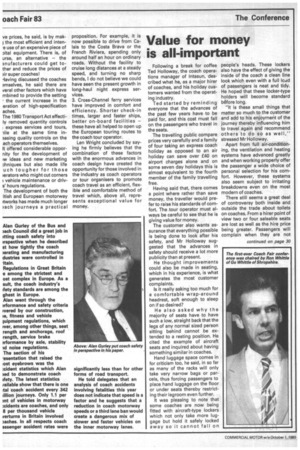"hree years is not clapped out'
Page 28

Page 29

Page 30

If you've noticed an error in this article please click here to report it so we can fix it.
ICHES ARE SAFE and a a great deal to offer. it was the reassuring ssage delivered to an ience of coach operators I tour agents and rators at Coach Fair.
he conference was ned by chairman Ron ittle, who introduced the akers — Len Wright of Wright Travel, Ted HoHof of lntasun, Verite Baker Ambassadors of Britain, in Gurley of the Bus and ich Council and Nicholas r of Wallace Arnold.
his opening paper, Len ght described the quality red by the modern highAication coach and a little of Industry's history.
e asked; "What is the ular image of coach travel?
s it bring back memories of Dol expeditions in cramped, ornfortable seats, of noisy ines, a standard of ride like a 'cle with square wheels, in;e heat in the summer but ice de the windows during win Dr anybody who still holds ;e images of coach travel, he one message. Times have nged. Over recent years, he said, there has been an incredible revolution in the coaching industry — not only in the design and construction of its vehicles but also in the services that it provides and the methods by which its services are marketed.
Having described the coaching revolution as a recent phenomenon, he pointed out that many of the changes have occurred in previous generations but it is only in the past few years that all the factors have come together in the right place at the right time.
Over 50 years ago, sleeping car services were started between London and Manchester using double-deck coaches with three axles, providing sleeping accommodation for 21 passengers, and kitchen and toilet facilities. If you were to add video and a few more seats, this could have sounded like the specification of one of the latest coach designs on display at Syon Park.
Unfortunately, these early high-specification coaches lacked the reliability, performance, comfort and capacity to make them a commercial success. They also, of course, had no modern road network on which to operate.
More recently, during the 1950 and 1960s, the coach industry passed through a period when the popular philosophy was that of maximum seats for minimum capital outlay. Each time the legally permitted length of coaches was increased, the reaction was to increase the number of seats, rather than to grasp the opportunity of increasing comfort.
During this period, hardly any manufacturer would consider producing vehicles with air suspension, because operators re,putedly preferred the simplicity and lower cost of leaf springs. Now it is virtually impossible to sell a touring coach that does not have air-suspension.
During the 1970s the so-called "executive" coach became established after several false starts. Initially, this development involved fitting tables, catering and toilet facilities to an otherwise standard coach. It was for a fairly small and exclusive market among football clubs, showbusiness organisations and business travellers. The general travelling public still managed with the traditional standard coach.
The fully equipped executive coach still caters for a relatively small section of the coach travel market, but it is an important section because it brings in customers who, a few years ago, would never have considered coach travel. The customer who normally drives a luxury car, rightly demands a smooth, quiet ride on his coach journey. He expects a comfortable, adjustable seat, and a quality sound system.
The modern executive coach will have a fully fitted bar and kitchen area, with on-board generator enabling all facilities to be used while stationary as well as on the move. For the business traveller, we compete with chauffeur-driven limousines, airlines, and first-class rail, but, as an example of the coaches' flexibility, none of these can actually take 20-30 customers together directly to the opening of a new factory, wine and dine them enroute without stopping and show them a promotional video of the products to be made at this new factory.
One of the most significant recent developments in the coach industry is the growth in demand from the general travelling public for the facilities previously found only in a small number of specialised coaches. He said his own company's markets have widened enormously and it finds now that, for it at least, the "standard" coach is becoming the 49-seater with: • Individually adjustable seats and reasonable leg-room for long journeys. This will always be a compromise between maximum comfort and economic load factors, but seat designs have improved and it is now rare to find the cramped conditions of the 57-seaters popular only a few years ago.
• On-board toilet and washroom. Even with regularly spaced service areas on most motorways, we find that this facility boosts the confidence not only of older passengers, but also of families travelling with young children.
• Refreshment facilities. Without losing seating capacity or incurring substantial additional costs, it is possible to provide a fridge for cold drinks as well as a hot-drinks machine serving a choice of, say, coffee, tea or chocolate.
• Efficient heating and ventilation systems. This is an area where there is still room for improvement, but it would be wrong to ignore the enormous advances made in recent years. All our vehicles, he said, have special combustion heating systems and many have doubleglazing. Gone are the days of winter journeys being marked by freezing condensation on the windows and icy draughts around your feet. At the other end of the climatic scale several operators now offer customers the option of full air-conditioning.
• Good quality sound and video systems. As coaches are being used for longer motorway journeys, passenger entertainment increases in importance. It must also be remembered, however, that not everyone wishes to listen to the music or watch the film, so all Len Wright Travel's new coaches have individual volume controls and headphone sets.
• Luxury interior trim. Much more thought is now going into coach interior design. There are purely practical additions such as sun-blinds and more durable lighting and ventilation fittings, but it is also important to create a restful, comfortable atmosphere.
To this end, he said he always specifies gangway carpeting and soft fabric trim to the interior panelling and ceiling, "It is remarkable how carefully chosen colours and materials can make an enormous difference to the air of luxury of a coach at marginal extra cost."
He then turned to the future, and said it is difficult to imagine further changes on the scale seen in recent years. The present generation of coaches is quiet, comfortable, reliable and safe. There is considerably greater strength and durability in the coachwork construction and the mechanical units perform efficiently and reliably over large distances at motorway speeds.
No manufacturer or operator can afford to be complacent, however, and there is room for detail improvement particularly in seating design, heating and ventilation systems, and layout of auxiliary equipment. It is no use, for example, having a sophisticated drinks machine positioned so that only a dwarf can operate it in comfort.
There has been much recent discussion about the future of double-deck coaches. The new generation of double-deckers, he said, offers very high standards of comfort and upwards of 70 seats. Their capital cost per seat, however, is no less than a 49-seat single decker. Thus, apart from prestige value, their only real advantage is on highmileage, intensive utilisation operations where real savings in labour and running costs can be made, and where the operator can be confident of filling the seats on a regular basis.
An area of development he would like to see is the super high single-decker or simpler design of double-decker, such as the Van Hool Astron or Daf Jonckheere P99, where a worthwhile increase in seating capacity can be achieved without either sacrificing comfort or incurring the enormous capital costs of some double-deckers presently on the market.
Mr Wright then talked of ti economic impact of purchasir equipment at this level. Ti coach he had been describin generally costs between £75,0( and E95,000. Only 10 years ag a good quality heavyweigi touring coach would co around £15,000. Coach tray has always been promoted i cheap travel. He thought it i evitable that coach operato would complain that prices a too low, while customers w complain that they are too high He said that if the industry is • build and maintain a reputatio not of cheapness, but of gm value for money, then the d velopment of the present gene ation of high-specificatic coaches must be paralleled 1 two changes of attitude: 1. The customer can no long regard a three-year-old coach "clapped out". The model coaches have a design life of least ten years and are capab of maintaining reliability ar high standards of comfort ar performance over that perio subject of course, to regul maintenance and interior re-k bishing after three to five years
2. The tour operators who, u derstandably, seek low prices enable them to sell holidays in competitive market can help ti coach operator achieve thol low prices on a sound ar profitable basis by plannir their programmes with an e) on achieving efficient utilisatic of coaches, For example, ti current demand for high-spec fication coaches on holiday e press services to the Mediterr nean resorts can only be met. economic prices if the vehicic are used regularly for weekdi departures as well as th popular Friday or Saturday d, partu re days.
The only way that we can offi a high quality service at comp,
ye prices, he said, is by mak; the most efficient and intene use of an expensive piece of pita' equipment. There is, of urse, an alternative — the 3nufacturers could get tother and reduce the prices of 3ir super coaches!
-laving discussed the coaches ?.mselves, he said there are veral other factors which have mbined to provide the setting the current increase in the eration of high-specification aches.
The 1980 Transport Act effectily removed quantity controls express services and tours, iile at the same time inmsing quality controls on the ach operators themselves.
It offered considerable oppornity for the development of AN ideas and new marketing hniques but also made life uch tougher for those )erators who might cut corners vehicle maintenance or drivs' hours regulations.
The development of both the itish and European motorway Aworks has made much longer ach journeys a practical
proposition. For example, it is now possible to drive from Calais to the Costa Brava or the French Riviera, spending only around half an hour on ordinary roads. Without the facility to cruise long distances at a steady speed, and turning no sharp bends, I do not believe we could have seen the present growth in long-haul night express services.
3. Cross-Channel ferry services have improved in comfort and efficiency. Shorter check-in times, larger and faster ships, better on-board facilities — these have all helped to open up the European touring routes to the coach tour operator.
Len Wright concluded by saying he firmly believes that the combination of these factors with the enormous advances in coach design have created the opportunity for those involved in the industry as coach operators or tour organisers to promote coach travel as an efficient, flexible and comfortable method of travel which, above all, represents exceptional value for money.




































































































